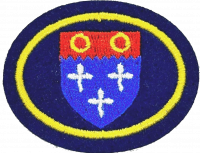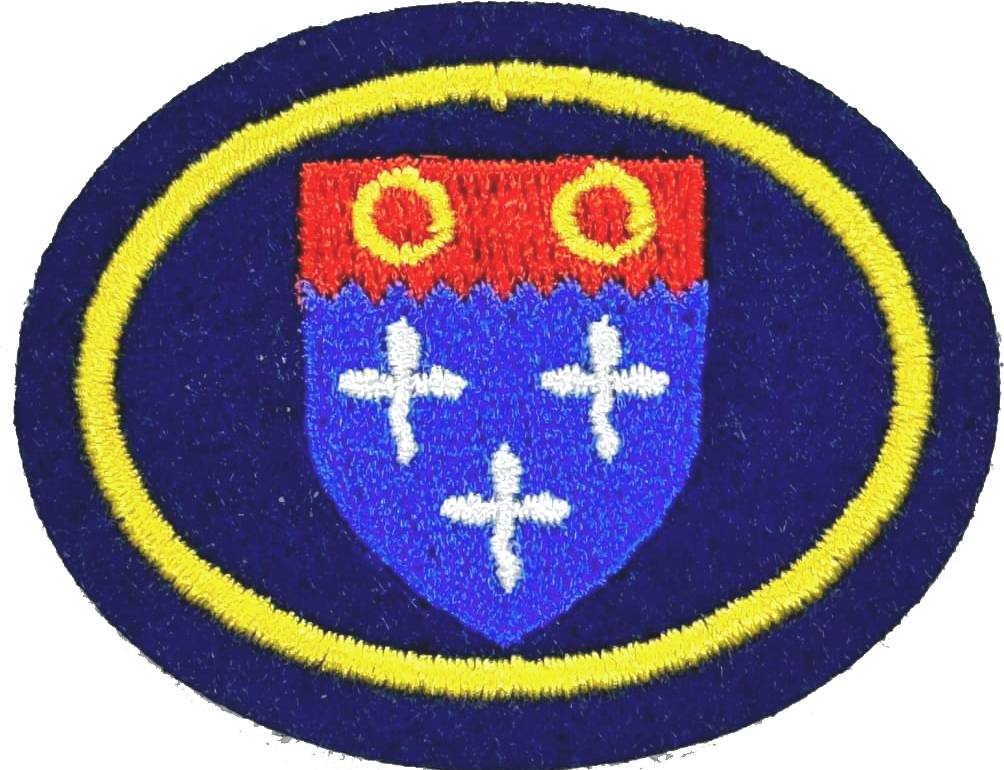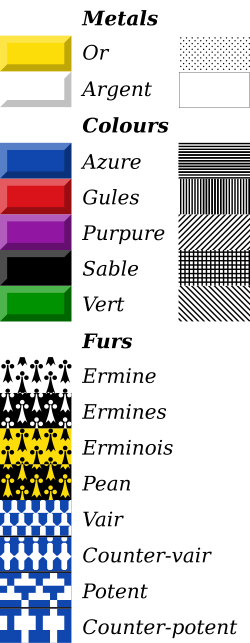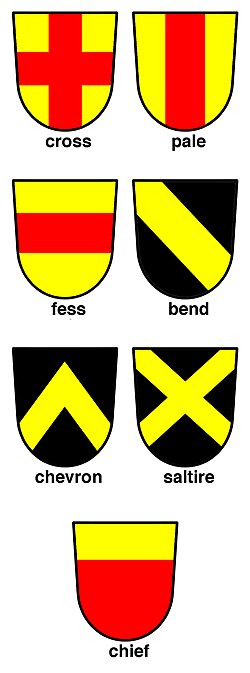AY Honor Heraldry Answer Key
1
In England, it started in the later 1100s, when in an age when literacy was rare, identifying knights in the joust and on the battlefield was difficult, especially with the introduction of their closed helmets.
To overcome this, the practice of painting unique combinations of colours, shapes and animals, called their 'arms', on their shields and banners came into being. Only one person was allowed to use these arms, so when people saw a knight wearing them in a battle or tournament, they could tell who he was.
Eventually the symbols migrated to battlefield shields and from there to the surcoats of men in armour, from which we may derive the term “coat of arms”.
Each coat of arms should be unique. The arms should be distinguishable at a distance, so the majority of components should be large, simple and composed of a very few tinctures (colours). The main charge (design on the shield) should cover its field (the whole of the space available on the shield).
Heraldry is about showing people who you are.
2
When heraldry began, knights and their families spoke Norman French. Expert 'heralds' still use this language to describe coats of arms. It's a very precise way of describing coats of arms. The description begins at top left, proceeds to the right and then, moving downwards, passes from left to right.
Originally the passport or DNA record of its time, there was no room for ambiguity, since it was used not only to pinpoint identity but also for faithful reproduction.
Over the centuries its precision has benefited both historical research and artists and craftsmen demonstrating their skills in accurately reproducing the arms it described.
3
Tinctures are plain colours found on the Escutcheon (shield).
The five traditional colours (tinctures) are, with their heraldic names:
- Red = Gules
- Blue = Azure
- Green = Vert
- Black = Sable
- Purple = Purpure
Plus the two 'metals'
- Gold or yellow = Or
- Silver or white = Argent
To ensure the clarity of contrast, heraldry created two rules:
- A colour object should not be placed upon a colour field.
- A metal object should not be placed upon a metal field.
- In design colours had to be separated by a metal.
The Tinctures’ Colour Code for placing on the shield:
- Red Gules - Vertical lines.
- Green Vert - Diagonal left lines.
- Blue Azure - Horizontal lines.
- Black Sable - Squares.
- Purple Purpure - Diagonal right lines.
- Silver Argent - Blank.
- Gold Or – Dots.
Areas of the shield could be also filled with patterns called Furs, the most common being:
- Ermine: representing the white winter fur of stoats, with their black tail tips.
- Vair: representing grey squirrel skins, in blue and white.
If something (say a dog or badger) is shown in its natural colours, it's called proper.
The rules do not apply to Furs or graphical charges coloured proper.
4
Tinctures are plain colours found on the Escutcheon. Different colours have different meanings, which can be found below:
- Silver / White – Argent: Signifies truth, sincerity, peace, innocence and purity.
- Gold – Or: Signifies wisdom, generosity, glory, constancy and faith.
- Black – Sable: Signifies wisdom, grief, constancy and prudence.
- Green – Vert: Signifies abundance, joy, hope and loyalty in love.
- Blue – Azure: Signifies loyalty, chastity, truth, strength and faith.
- Red – Gules: Signifies magnanimity, military strength, warrior and martyr.
- Purple – Purpure: Signifies temperance, regal, justice, royal majesty, and sovereignty.
Furs refer to patterned designs on the Escutcheon.
They also have meanings:
- Ermine White (the most common fur) Valour, justice and dignity. This is a regal fur, since ermine has long been associated with the crowns and robes of royal and noble persons.
- Pean Black (a representation of Ermine) Valour, justice and dignity.
- Ermine Black (the reverse of Ermine White) Valour, justice and dignity.
- Erminois Gold (the reverse of Pean Black) Valour, justice and dignity.
- Vair (Blue and White bell shapes) Great wealth.
5
Ordinaries are the simple shapes used on heraldic shields, against a colour, metal or fur background.
The shield, or escutcheon, has changed shape over the centuries but its surface (‘field’) has always been the area on which armorial bearings are usually displayed. The shape used is of personal choice.
The face (‘field’) of the shield was divided into different blocks of colour that were echoed in the development of a variety of shapes which, when arranged on a knight’s shield in a particular design, were said to be their owner’s ‘arms’.
As this peculiar science-cum-art developed and became regulated by the heralds, the shapes were named, described and categorised as the Ordinaries.
Some of the Ordinaries are listed below:
| Fess = horizontal stripe across the shield | Chevron = like a house gable, pointing upwards | Chief = bar across top edge of shield |
| Pale = vertical stripe down the shield | Cross = a plain cross | Bordure = border round edges of shield |
| Bend = diagonal stripe | Saltire = a 'St. Andrew's cross' | Pile = downward-pointing triangle |
Also, the shield can be divided into two colours, either vertically or horizontally, or into four different-coloured quarters.
6
By 1200 the impact of the melting pot of knightly pan-European culture only intensified the need for something which would more personally identify the bearer of arms.
The solution – graphical charges – opened a vast, less geometric, array of images.
Charges are emblems added to the shield, on the background, the 'ordinary', or both. There can be one big charge, or several smaller repeated ones and of any colour.
Anything seen or imagined could be represented either in its natural colours or in a fanciful, stylised version.
In the animate category, animals, birds, fish, reptiles, insects and monsters were all possibilities, as were divine or human beings.
As for inanimate objects, everything appeared from an anchor and an axe to a wheel and a woolpack by way of trees, plants, flowers and celestial objects.
7
Of all the graphical charges in heraldry, animals have always played a large and significant role.
Any animal - either one big one or several smaller - can be used as a charge. They can be shown in many different ways, for instance:
- Rearing up (rampant) - like the lion and the hare in the pictures.
- Standing (statant) - like the dog.
- For birds, with wings outstretched (displayed) - like the eagle.
- Walking along (passant) - like the other lion.
If the animal is looking towards you, it is also guardant or 'on guard'. So the lion in the picture is passant guardant.
The ancient royal arms of England are three golden lions, one above the other, walking along on a red shield: or in heraldic code gules three lions passant guardant.
In a semicircle of flags, the national flag should be in the centre.
When flown with state, province and house flags, the order of precedence is national, state or province and then house.
8
9
10





